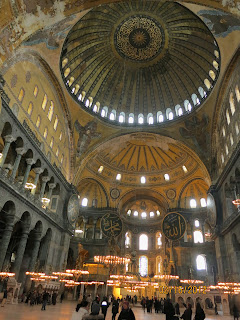Daphne and I decided that we should really expose the kids to the history of the city.
We hired a tour guide through the hotel to give us a three hour architecture tour of the city. It promised a view of three important mosques that show the history and importance of the city.

Here's poor Max - a PhD in Byzantine Art and Architecture - showing us the first mosque built in honor of the prince Mahmet. Sehzade Camii was impressive. Not only a place for worship but also a school, soup kitchen, community center, and general garden for the neighborhood.
Don't let the photos fool you. Brian was tired and cold. The 9am start was too early for his vacation schedule. Here we are in the court yard.
We moved on to Suleymaniye Mosque which is the most important mosque in the entire city. Built in 1550, it also was a charitable foundation more than a place of worship. It includes a hospital, soup kitchen, schools, and bath house.
 It fed over 1000 of the poor every day - Muslims, Jews, and Christians. Incredible limestone building on a huge complex that was built in seven years. We couldn't do a kitchen in 6 months.
It fed over 1000 of the poor every day - Muslims, Jews, and Christians. Incredible limestone building on a huge complex that was built in seven years. We couldn't do a kitchen in 6 months.The interior is soaring with the height of the dome exactly double the diameter. Bright colors and artistic frescos.
The architect was unusual in that most were just government employees. But Sinan, who designed the three we saw on our tour was Christian, educated in elite palace school and died at age 97 having built 131 mosques and 200 other buildings.
We learned that some of the glass came from Venice. The boys were not sure they remember visiting Venice. (Happy we made that trip - but ask them the lyrics to a lady gaga song - no problem).
 We went outside to the courtyard and could see the Bosphorus and the Bazaar below. The kids were more impressed with the feral dogs and cats. The dogs are captured and neutered. The cats are left to run free. This works well because it is custom that it is bad luck to throw away food. Hence - the animals get fed.
We went outside to the courtyard and could see the Bosphorus and the Bazaar below. The kids were more impressed with the feral dogs and cats. The dogs are captured and neutered. The cats are left to run free. This works well because it is custom that it is bad luck to throw away food. Hence - the animals get fed.
Here is Daph viewing the harbor from the palace entrance to the most important mosque in Istanbul.
















































